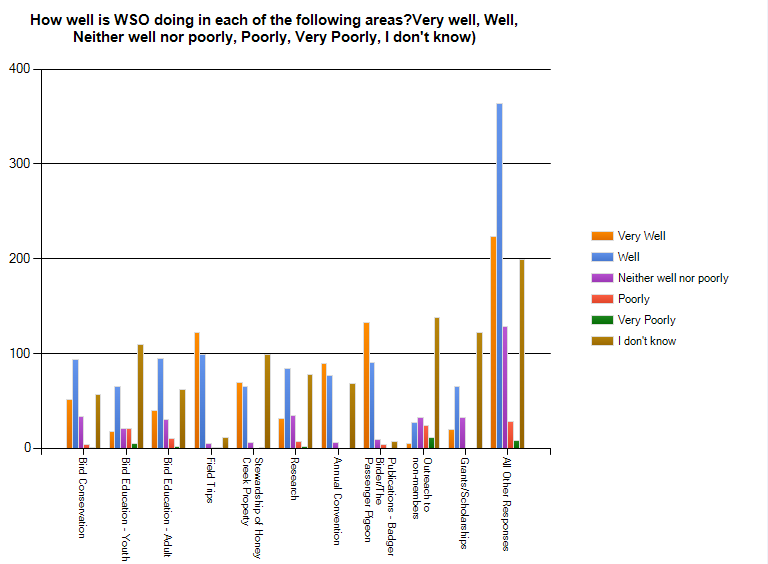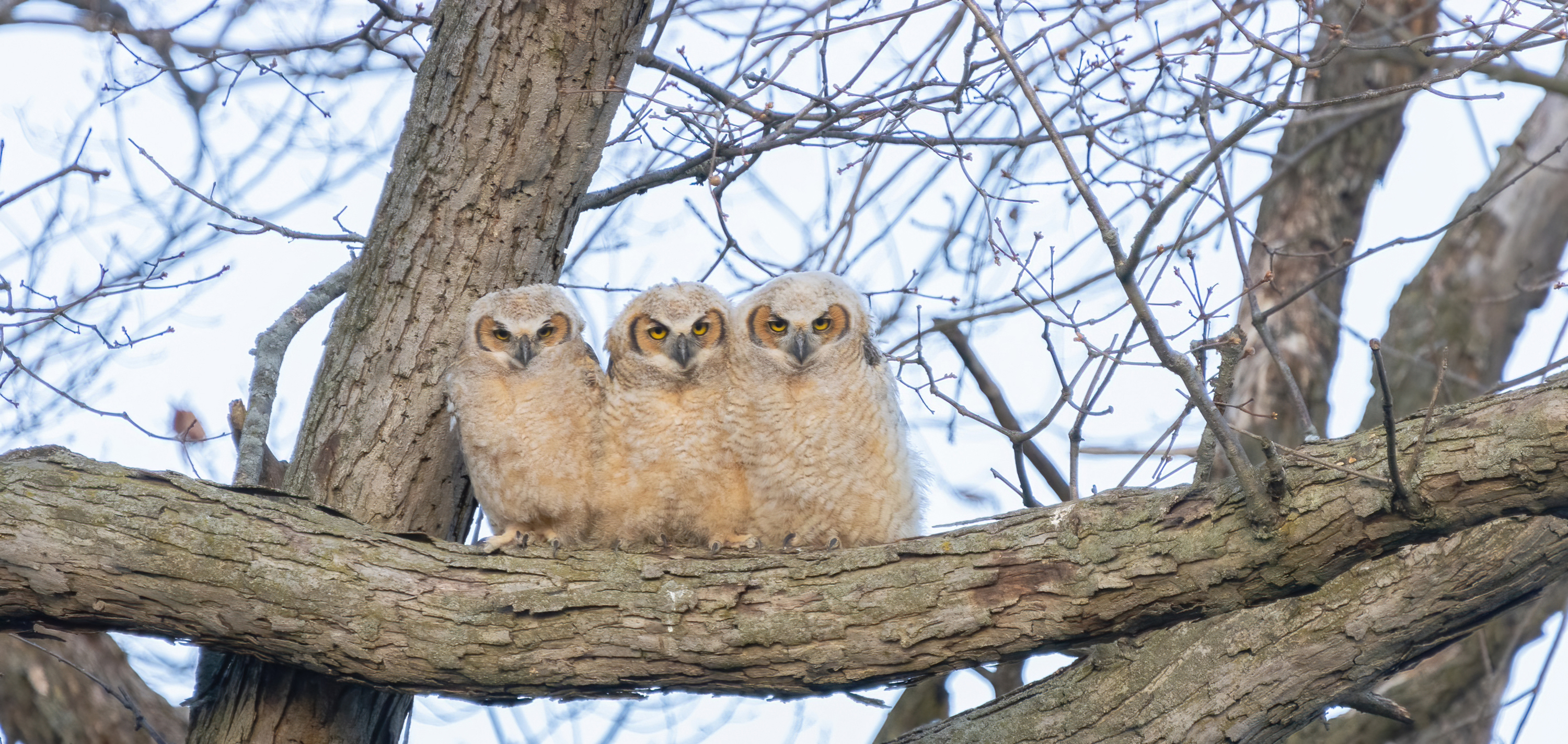The Future of Birding: Chapter 1 of Our Report on WSO’s Strategic Planning Survey
Late last fall the Wisconsin Society for Ornithology embarked on a strategic planning effort to better identify the needs of its members as well as those of other birders in the area. To gather information on what birders would like to see done to increase their birding enjoyment, surveys were developed to get at the question of what benefits WSO can provide to make birding more personal.
Birders have as many reasons for birding as there are bird species. There always have been many different organizations and avenues to accommodate this diversity, and the explosion of social media has greatly expanded birders’ communication capabilities. Wisbirdn, the Wisconsin Birding Network on Facebook, Wisconsin eBird, and local bird club email lists all have given birders ample new ways to interact.
What’s been missing is a data-driven effort to fulfill the desires of birders themselves. That’s why WSO set out in November (with the help of Survey Monkey) to survey its members and, separately, a range of birders in the state who don’t belong to WSO. Now the Strategic Planning Committee, led by DNR conservation biologist and former WSO President Randy Hoffman, has begun its analysis of those responses. The committee was thrilled by the survey response rate. Our member survey drew 259 responses from among our roughly 1,100 members, far exceeding the 10-15% response rate that most surveys hope to achieve. We also found some additional WSO members among the 112 responses to a separate non-member survey distributed via Wisbirdn, Facebook, eBird and several local birding groups.
This is the first of four reports on the survey results that will appear monthly in the Badger Birder and on our web site, www.wsobirds.org , leading up to the annual WSO convention in Ashland May 23-26, where it will be discussed at the organization’s annual business meeting. The complete survey is on the web site to let folks see results in detail, draw their own conclusions and offer WSO leaders additional feedback. wsobirds.org/survey
The committee met on Jan. 4 and, at the suggestion of WSO historian and former president Noel Cutright, began its discussion with each member listing their top take-home-messages from the survey results. There was considerable agreement and overlap, and these seven points stood out.
- Conservation activities are critically important to our members. Many value our contribution to bird research, but want to see WSO move further beyond “enjoying” birds to do more to protect them.
- There was a lack of negativity, and most aspects of WSO’s efforts drew high ratings. “No gloom and doom here,” one member remarked.
- Scoring top marks were field trips, publications, conventions, the records committee and support for scientific studies.
- There were a number of areas where folks lacked knowledge about what WSO is doing, suggesting we don’t do a good job of internal communication and marketing. Some saw a need for more transparency about board activities.
- There was a recognition that we need to do a better job of targeting younger birders and meeting their needs.
- Many of our members are embracing electronic communication (eBird, Wisbirdn, Facebook, wsobirds.org) but we risk alienating members if we abandon or degrade our print publications.
- We need to be a friendlier bunch, starting at the top, but throughout the organization. Some newcomers don’t feel as welcome as we could make them feel, and there is concern that we cater too much to “expert” birders and don’t do enough to help the “amateurs” and those who are most interested in bird-feeding.
Because the strategic planning committee includes three of the five current WSO officers and intends to be in close touch with entire WSO board, there is an expectation that it will move quickly to implement member feedback in some areas where there is strong consensus. Creation of a Communications Committee, upgrades to the WSO web site and launch of a WSO Facebook page are just a few such examples where feedback already is having an impact. The committee also is discussing options for expanding activities for members in parts of the state where our membership-density is lower, and the Ashland convention is one effort in this area. Other initiatives, including any that would involve structural changes, will require longer and broader discussion, with May 2014 envisioned as the final implementation date.
Here is a quick look at what else we have gleaned from the first six questions in the member survey:
- While we received survey responses from every corner of the state, our membership clusters appear to mirror the state’s population. Some 40% of our responses came from Milwaukee (36), Dane (35) and Waukesha (19) counties; they were followed by Outagamie, Brown, Ozaukee, Portage, Sheboygan, Washington, Marathon (all fewer than 10) to round out the top 10.
- We have a fair number of members in three neighboring states. Responses from Michigan (5) outnumbered all the remaining Wisconsin counties and Illinois and Minnesota (3 each) outnumbered all but four other counties.
- Some 63% of our respondents were over 55, and only 16% were 40 and under. Just 4% were under 25. Is ornithology in Wisconsin, at least as defined by WSO, largely a retirement pursuit? Or are we not appealing to younger birders?
- Of our respondents, 61% were male.
- Why do folks belong to WSO? Survey Monkey lets you do text frequency analysis of the written responses. The word that occurs most often is SUPPORT — for birds, for WSO, for research. Not surprisingly there is a strong local thread in this and other sets of answers; our members want to know more about WISCONSIN birds, individual species, issues, study. They LOVE birds, they love FIELD TRIPS.
- We asked folks to describe their relationship to birdwatching. While many nonmembers see us as a premiere and elite group of ornithologists, academics made up only 14% of WSO respondents. Some 56%, though, see themselves as citizen science volunteers. And while 90% of us are backyard birders, 81% are also destination birders, which may help explain the 61% Wisbirdn membership.
- At 47%, eBird contributors ranked higher than some of us would have guessed, and the 32% Facebook membership also was interesting, given the relative newness of that option with both the Wisconsin Birding Network and WSO’s own page.
- Our members are active locally (65% belong to a local bird club or Audubon) but less so nationally (48%).
- WSO gets the highest marks for field trips and publications, followed by the Records Committee and the convention. “Don’t know” responses dominated youth education, Honey Creek stewardship, outreach to nonmembers and scholarships.
- No category found more than 10-15% poor/very poor, and most areas scored in the low single digits for negative ratings.
In March, we’ll examine the non-WSO-member survey feedback, and in April we’ll take an in-depth look at what members had to say about The Passenger Pigeon and the Badger Birder, as well as where else they go for their birding information. And in May we will examine the rest of the survey, focusing more on what changes members want to see in their Society, leading up to the annual meeting at the Ashland convention.
In addition to Hoffman and Cutright, the Strategic Planning Committee includes WSO President Carl Schwartz, Vice President Kim Kreitinger, Passenger Pigeon Editor Bettie Harriman, Field Trip Committee Co-Chair Tom Schultz and Education Committee Chair Bill Mueller.
For a look at the complete membership survey, including charts displaying some of the results, go to wsobirds.org/survey


